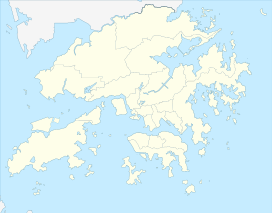Victoria Peak
| Victoria Peak | |
|---|---|
 The top of Victoria Peak, with the radio stations | |
| Highest point | |
| Elevation | 552 m (1,811 ft) Hong Kong Principal Datum |
| Prominence | 552 m (1,811 ft) |
| Geography | |
Victoria Peak (Chinese: 太平山, or previously- 扯旗山) is a mountain in Hong Kong. It is also known as Mount Austin, and locally as The Peak. The mountain is located in the western half of Hong Kong Island. With an altitude of 552 m (1,811 ft), it is the highest mountain on the island proper, but not in the entirety of Hong Kong, an honour which belongs to Tai Mo Shan.
The actual summit of Victoria Peak is occupied by a radio telecommunications facility and is closed to the public. However, the surrounding area of public parks and high-value residential land is the area that is normally meant by the name The Peak. It is a major tourist attraction which offers views over Central, Victoria Harbour, and the surrounding islands.
History


As early as 19th century, the Peak attracted prominent European residents because of its panoramic view over the city and its temperate climate compared to the sub-tropical climate in the rest of Hong Kong. The sixth Governor of Hong Kong, Sir Richard MacDonnell had a summer residence built on the Peak circa 1868.[1] Those that built houses named them whimsically, such as The Eyrie, and the Austin Arms. See First houses on the Peak.
These original residents reached their homes by sedan chairs, which were carried up and down the steep slope of Victoria Peak. This limited development of the Peak until the opening of the Peak Tram funicular in 1888.[1][2]
The boost to accessibility caused by the opening of the Peak Tram created demand for residences on the Peak. Between 1904 and 1930, the Peak Reservation Ordinance designated the Peak as an exclusive residential area reserved for non-Chinese. They also reserved the Peak Tram for the use of such passengers during peak periods. The Peak remains an upmarket residential area, although residency today is based on wealth.
Tourism



With some seven million visitors every year, the Peak is a major tourist attraction of Hong Kong. It offers spectacular views of the city and its harbours. The number of visitors led to the construction of two major leisure and shopping centres, the Peak Tower and the Peak Galleria, situated adjacent to each other.
The Peak Tower incorporates the upper station of the Peak Tram, the funicular railway that brings passengers up from Hong Kong's Central district, whilst the Peak Galleria incorporates the bus station used by the Hong Kong public buses and green minibuses on the Peak. The Peak is also accessible by taxi and private car via the circuitous Peak Road, or by walking up the steep Old Peak Road from near the Zoological Botanical Gardens.
Victoria Peak Garden is located on the site of Mountain Lodge, the Governor's old summer residence, and is the closest publicly accessible point to the summit. It can be reached from Victoria Gap by walking up Mount Austin Road, a climb of about 150 metres (490 ft). Another popular walk is the level loop along Lugard Road, giving good views of Hong Kong's Central district and Kowloon, and then returning via Harlech Road, encircling the summit at the level of the Peak Tower.[3] There are several restaurants on Victoria Peak, most of which are located in the two shopping centres. However, the Peak Lookout Restaurant, is housed in an older and more traditional building which was originally a spacious house for engineers working on the Peak Tramway. It was rebuilt in 1901 as a stop area for sedan chairs, but was re-opened as a restaurant in 1947.
Rickshaw ride is also available outside the Lion Pavilion on Findley Road, provided by one of the few remaining licensed rickshaw pullers in Hong Kong. [4]
Natural history
The Peak is home to many species of birds, most prominently the Black Kite, and to numerous species of butterflies.
Alternative names
| Name | Native Cantonese (Jyutping) | Etymology |
|---|---|---|
| 太平山頂 | taai3 ping4 saan1 deng2 | literally means "pacific mountain peak" or "mountain peak of great peace" |
| 山頂 | saan1 deng2 | corresponds to the English name "The Peak" |
| 扯旗山 | ce2 kei4 saan1 | literally means "flag-raising mountain" |
| 爐峰 | lou4 fung1 | literally means "furnace peak" |
| 維多利亞山 | wai4 do1 lei6 aa3 saan1 | A phonetic transliteration of the English name "Victoria Peak" |
| 柯士甸山 | o1 si6 din1 saan1 | A phonetic transliteration of the English name "Mount Austin" |
See also
- List of mountains, peaks and hills in Hong Kong
- The Peak Hotel, a hotel located on Victoria Peak from 1888 to 1936
- List of buildings, sites and areas in Hong Kong
- Tourism in Hong Kong
- List of places named after Queen Victoria
- Peak Reservation Ordinance
References
- ^ a b "The Peak History". The Peak. Archived from the original on 7 March 2007. Retrieved 14 March 2007.
- ^ "Peak Tram History". The Peak Hong Kong. Archived from the original on 20 February 2007. Retrieved 13 March 2007.
- ^ http://www.thepeak.com.hk/full/en/nature.php
- ^ http://forgotten-transport.blogspot.com/2011/09/does-rickshaw-still-exist-in-hong-kong.html

